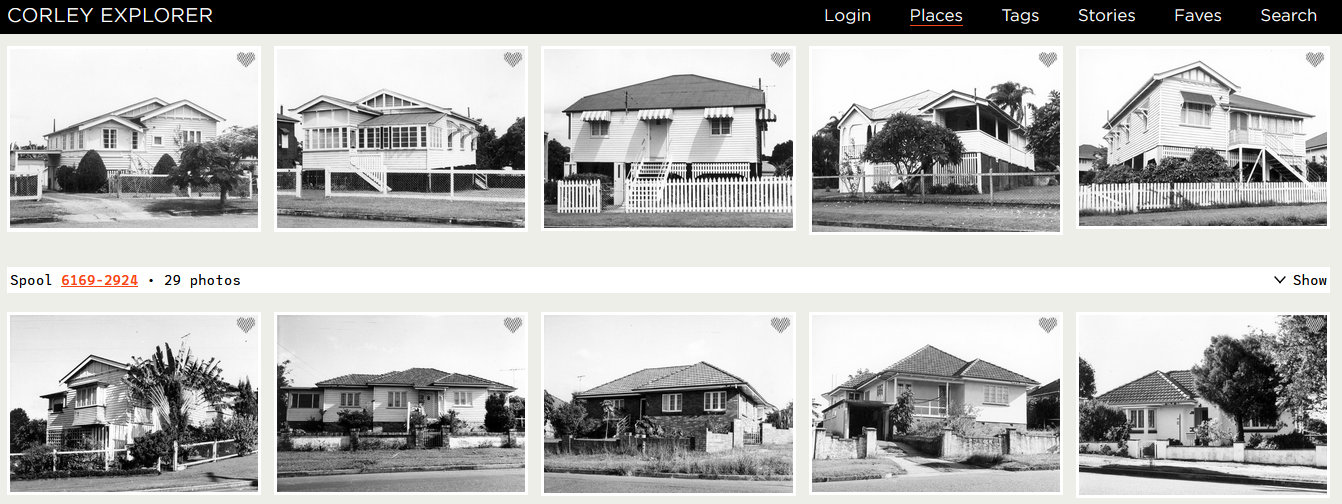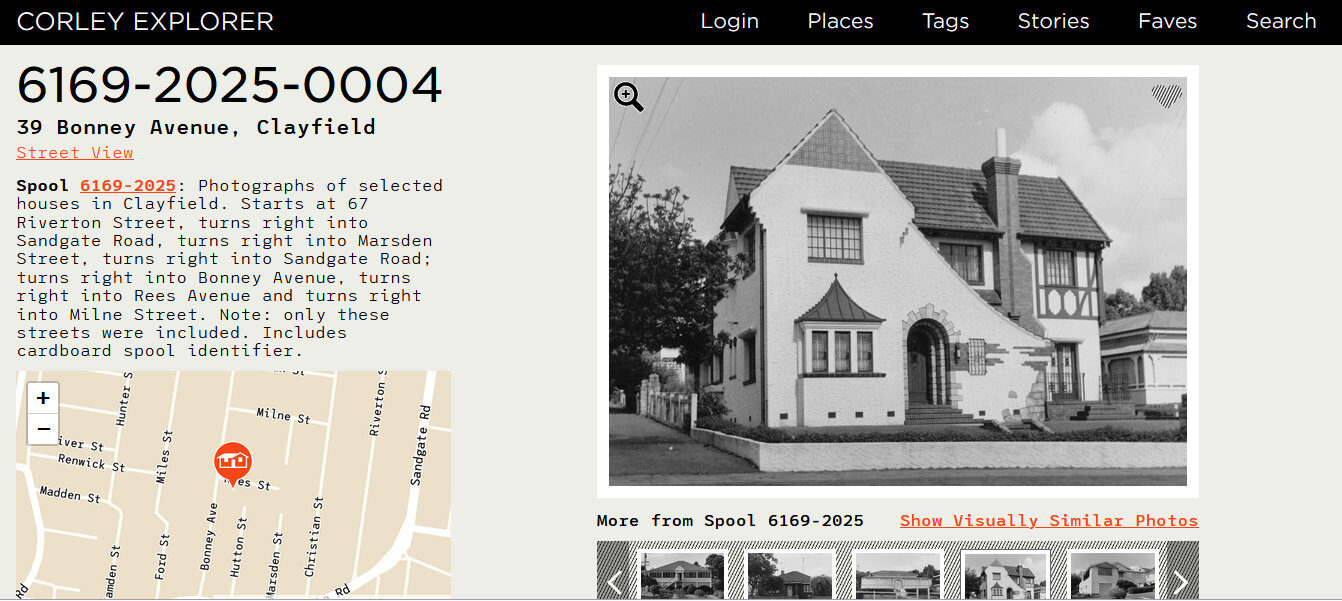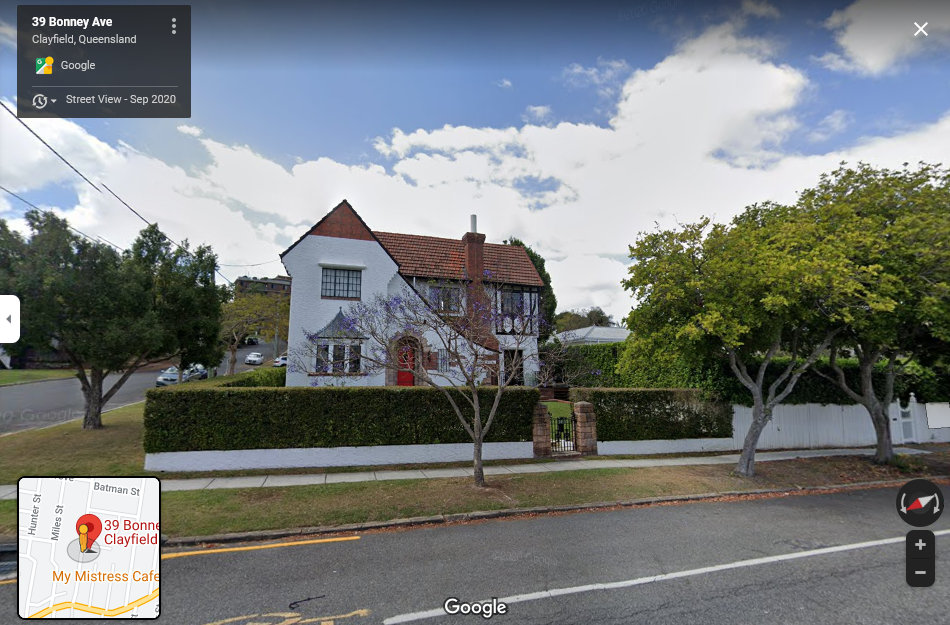If a picture is worth a thousand words, then here is 61 million of them.
The State Library of Queensland has triumphantly executed a mammoth project by showcasing 61,000 historic images of Queensland houses, captured in the ’60s and ’70s by the late Frank Corley. The Corley Explorer project aims to match the house photos with locations and anyone who lived in the homes, in an effort to provide context and stories about them.

In an age where the urban sprawl of characterless property development estates churn out ‘affordable’ housing with almost identical floor plans, there is a real charm and yearning for classic Australian homes. The weatherboard and fibro shack with corrugated tin roof, particularly the stilted ‘Queenslander’, are quintessentially Australian. Like a lousy country town bakery mince meat pie, these seemingly ordinary houses represent a bygone era of a fledgling nation with strong ties to the Commonwealth.
Many homes constructed in the early 20th century feature a British Edwardian-style of architecture, but with some breakaway features that were unique to Australia. This mostly stemmed from coping with vastly different sub-tropical to tropical climates.
For better or worst, many old houses have since been knocked down and replaced with sleek modern constructions. But back in the ’60s and ’70s, homes now considered ‘classics’ lined the Brisbane streets and Frank Corley was there capturing them.
‘From the 1960s to the 1970s, Frank and Eunice Corley drove the suburban streets of Queensland in their pink Cadillac, taking photographs of houses and selling them to homeowners,’ the State Library of Queensland Corley Explorer website explains. ‘They are thought to have taken over a quarter of a million photographs of houses, from Bundaberg to Beenleigh. Around two-thirds of the photographs were sold to householders, and the remaining 61,000 images were donated to State Library in 1995.’
The Library spent immense resources building an interactive online database, where users search for houses and submit stories, resulting in a user-generated public record that does great justice to the vast photo collection. It’s serves to benefit the public in a more meaningful way than simply digitising the archive and storing it as a record.
The Library also produced videos explaining Corley’s process and what went on behind the scenes to construct this project. And the Library’s decades-long job of making sense of the 61,000 prints, which were handed over with practically no notes or contextual information, is as much a part of the story.


Australia’s original ‘Google Street View’
Frank and his wife, Eunice, had an entrepreneurial streak in the ’60s and ’70s with the The Corleys’ Pan-American Home Photographic Co. The business model goes something like this: Frank slowly drove around the streets of South East Queensland, steering the car with his knees while photographing every house as he passed by with his Leica.
‘His wife Eunice would park a mobile developing unit [in a Bedford delivery van] nearby and she’d develop the photographs and then they’d get a salesman to try to sell the photos back to the home owners [as postcards, greeting cards, calendars],’ said State Library of Queensland program officer, Chenoa Pettrup, to the ABC. ‘Cameras weren’t really in the homes as much at that particular time, so it was quite a novelty to get a photograph of your house and a nostalgic thing for that they could share with their families.’
In the early 1990s Doug Spowart was working at a South Brisbane photo gallery, where he met and befriended an elderly Frank Corley. Doug and his partner, Victoria Cooper, visited Frank at his home after Eunice passed away and was shown the archive along with Eunice’s mobile dark room.
‘I called him the man who photographed every house in Australia — the original Google Street View,’ Doug told ABC.
Recognising Corley’s archive was ‘history – an amazing resource’, Doug and Victoria encouraged the retired photographer to donate the photos to the State Library. ‘How could you pass up on a record of Queensland like this? It would have just been lost,’ said Doug. From a photography perspective, Doug finds the images are merely functional – ‘essentially a plan elevation’, which as standalone photos aren’t remarkable. But half a century later this large volume of mostly black-and-white images, captured in an identical style, serves as a valuable historic
In 1995 Doug facilitated Corley’s archive donation to the State Library of Queensland, and shortly later Frank passed away. Niles Elvery, former field officer at the John Oxley Library, a sector of the library handling research of historical records, was the first individual to inspect Corley’s archive.
‘I remember arriving at the Corley’s house. And this is a huge collection of material that was in danger. If we didn’t go and get it, it wouldn’t be there. And we’ve got to get it out in a big hurry. A number of boxes had collapsed and come apart. Some of them, I think, had been wet. So I was very aware that when the material came back to the State Library, it would be some sort of a task to actually try and put it back together.’
Some of the photos experienced water damage and had stuck together. So the library’s paper and photography conservators used a cold steam pencil, which can ‘in a very controlled way apply moisture, re-swell the gelatin layer and the emulsion layer’ to separate them. After separating the photos some are left with cracks and are lifting from the paper support. These go through a ‘consolidation’ process, whereby a gelatin adhesive is painted on with a fine brush, along with water and ethanol, to stick them back down and prevent further image loss.
The Corley archive then went to John Wilson, a Library volunteer and former CSIRO research scientist, who spent four years working with the pictures to create a manageable cataloguing system. And in 2014 Brisbane community history organisation, the Annerley-Stephens History Group, sent volunteers onto the streets to match pictures with houses.
‘The collection gives you the chance to grab a whole heaps of history by involving the community,’ said Dennis Peel from the Annerley-Stephens History Group. ‘We’ve used it as a way to get people to walk the streets, look for the houses, and find out if they’re there. Then we have a community meeting and they [house occupants and former occupants] start to tell us the stories of their houses and it’s a great neighbourhood building experience.’

So far almost 3000 stories have been submitted attached to houses submitted by people who lived in or around the premises. Dennis’ favourite story involves one house with a motorbike out the front. That motorbike is said to be the first of its kind in Australia with a car engine installed in it, and the owner still rides the bike to this day down in Victoria where he works as a wine maker.
‘It’s such a unique collection. There is no other record of that number of houses in that time – the 1970s. We not only have Brisbane, but regional areas covered as well, which is very important. I think a lot for the availability of it now is down to the volunbteer, John Wilson, who worked so diligently and was so determined to try and find the location of every photo. It was his great efforts that really made it available.
Check out the Corley Explorer.





Hello,
I have been trying to see the photographs like I was previously able to, however they are now blank with information only. Do you have to subscribe to see them now?
Having had a good look at this on-line collection I am astounded that any cash-strapped State Library (and they all are) thought it was a good idea to digitise sixty odd thousand photos that nobody wanted originally either because they could not afford them or they just didn’t like them.
Now, 50 or 60 years after the event, the only people interested are mostly those looking for a photo of their childhood home – and most cannot find what they are looking for anyway because two thirds of the photos taken were sold and only unsold prints still exist – not the negatives.
Several local history Facebook pages promoted this collection as some sort of alladin’s cave but the common reaction is that few people can find the house they are looking for. Compounding the problem is that not all streets and not many street numbers are recorded unless this info happens to be in the photo itself. Many older homes do not look the same after 50 years and in housing estates there were often many houses built to the same plan.
The basis of my opposition to wasting significant resources scanning thousands of low value photos is that while it might sound like a great idea that will generate lots of online clicks, many state libraries, including Queensland, have had to resort to placing some historic photos on Flickr in the hope of discovering their backstory from the crowd. This is because they cannot afford enough researchers.
Love this collection, have been able to find many houses in my area, unfortunately not my own – but that’s ok. Love being able to see what the houses in my area originally looked like. Will be sharing with my neighbourhood! Thank you!
Unfortunately the house at 30 Maddocks street, Virginia, even thought it is a pre 1946 house that Frank photographed ( 6169-1911-0011) has been given permission by Brisbane City Council to be demolished so a new modern house can be built.
It is a shame to see these historic home torn down and history lost even when we have rules in place to supposedly protect them.